

8 Easy Chemistry Experiments At Home (Get a Great Reaction!)

If you want to have some fun with chemistry at home, there are three main ways to go about it. You can buy a chemistry set, subscribe to a subscription box, or find some instructions and use household items. However you go about it, chemistry is a great way to get kids excited about chemistry and science in general.
Related post: Best STEM Subscription Box for Kids (Ultimate Guide 2024)
Chemistry Sets and Subscription Boxes
Before we dive into easy experiments, you can do with things you’ll probably have at home. I just wanted to talk a little bit about your other options.
Chemistry sets can be an excellent investment. They come with equipment that you can reuse over and over. It’s a lot cheaper than having to replace your drinking glasses and measuring jugs because the kids keep using them for chemistry experiments! They also come with instructions on a range of experiments that you can try. If you’ve done a few of the experiments below and are looking for something more, a chemistry set can be a really good option. There are ones aimed at young kids all the way up to teenagers .
Another great option to consider is subscription boxes. These are great for extending learning and keeping kids entertained and engaged for a more extended period. There are loads of great options to choose from. But, when it comes to chemistry, you really can’t go wrong with MEL Science . They have two subscription levels, so you can get a big box or a small one each month. Because everything is in the box, it really takes all the planning and hunting for ingredients out of the equation.
Experiments Using Household Items
If you don’t have a science kit on hand and are looking for something quick and easy to try at home, then these are the experiments you should try. Most of these use items that you will probably have at home, although a few might require you to get a little creative or grab the odd thing the next time you go to the shops.
Chromatography
Chromatography is a technique used in chemistry. It lets you find out what’s inside chemicals. In this version from Fizzics Education, you’ll see what colors are mixed up inside felt tip pens. It’s a straightforward experiment to carry out. All you need is some paper towels, felt tips, and a glass of water.
This is a simple version of this experiment, but there are some easy ways to make it more interesting or scientific. One way to extend this experiment is to try the same technique but using your favorite sweets’ colorings.
For instance, sweets like M&Ms, Skittles, and Smarties all have food coloring on their outside. You can get a sample of this coloring by sitting the candy in a small amount of water. Then you use the colored water in the same way as the felt tip pens.
To add a bit of rigor and math to the experiment, you need a pencil and a ruler. Instead of drawing a line of felt tip, you draw a line with a pencil. Then put a spot of the felt tip on the pencil line. When you take the paper out, you mark a second pencil line to show how high the water went.
By measuring the distance, each of the colors went and the distance the water went, you can calculate something called the retention factor. The retention factor will be unique for different dyes. To find the retention factor, you take the distance your sample travels and divide it by the length the solvent (water in this case) traveled. You can use this number to see if the same dye is used in different pens.
Pop Rockets
This is one of my favorite chemistry experiments for kids. It does get a little messy, so make sure you have some cloths on hand. Alternatively, you can do it outside to make it a little easier to clean up. Steve Spangler Science has some great instructions to follow.
In their version, they use an old film canister. But these can be a bit hard to get hold of these days since everything is digital. Some good alternatives that work well include empty glue stick containers. It’s also worth keeping your eye out for any food containers with push-on lids, as these can work well. There are always a lot of good options around Halloween, Christmas, and Easter – the snack size containers tend to be pretty good options.
The reason I love this experiment is that it’s a lot of fun. There’s the excitement of the pop and watching the canister fly. But, there are also a lot of opportunities to turn this into a real investigation. You can try changing the volumes of liquid or the type of liquid. You can find the best mix to make the biggest noise, the loudest pop, or the perfect mix to make it pop in precisely 8 seconds.
Make Oobleck Dance!

Oobleck is the name that’s been given to an awesome type of slime that you can make at home. If it sounds like something out of Dr. Suess, that’s because it is. This slime is just a mix of cornstarch and water, so it’s pretty easy to make. These instructions from Housing A Forest are pretty good.
What’s cool about Oobleck is that it’s a Non-Newtonian solid. That means that it behaves a little differently than you might expect. For instance, when you try to stir it quickly, it gets hard and almost solid. If you run your fingers through it slowly, it flows like runny syrup.
Now just playing with this stuff is fun, but if you have a speaker to hand, you can do something even cooler. In the guide from Housing A Forest, they suggest using a subwoofer and a cookie sheet. The speaker’s vibrations make the Oobleck bounce around and switch from a solid to a liquid to the beat of the music.
If you have an old speaker that you don’t mind breaking, you can wrap the speaker in saran wrap and put the Oobleck straight onto that. It works a lot better, but if you don’t cover the speaker correctly, it can break.
Make Rubber Eggs
Eggs are an excellent ingredient for science experiments. This experiment from 3P Learning lets you turn a hardboiled egg into a bouncy rubber one. To do this, all you need to do is soak it in vinegar for a day or so. This will dissolve the calcium carbonate of the eggshell. When it’s done, you’ll be able to rub off the tough outer shell.
Without the shell, you’ll be left with the membrane that lines the shell. This membrane helps hold the egg together. This membrane is strong enough to drop the egg onto a surface from a reasonable height, and it will bounce back without falling apart.
The harder your egg is, the less it will bounce. If you want a mix between bounciness and minimal potential for mess, then you’ll want to aim for a soft boiled egg. But, if you don’t mind the mess, try a raw egg. You remove the shell in the same way. When it comes off, you get a peek inside the raw egg. Because it’s raw, it’s squishy and bounces better. Of course, if you drop it from high enough, it will break. When you do this, you’ll find the stretchy membrane, which is pretty cool to feel.
Lemony Eruption
I’m sure you’ve all done the classic volcano eruption with baking soda and vinegar. This is a twist on that experiment. It takes advantage of the fact that lemons are already full of natural citric acid. Here are some great instructions from Babble Dabble Do. They have some handy tips on how to make the most out of each lemon. The great thing about this version is that your room will smell lovely and lemony for the rest of the day.
If you want to extend this, you try investigating which other fruits this would work with. You could explore a whole citric family of volcanoes.
Concoct Some Invisible Ink
Write Secret Messages With Invisible Ink! by Science Buddies
Making invisible ink is really easy. There is some fun chemistry behind how it works. As a bonus, once your kids get the hang of it, they’ll have loads of fun sending coded messages. It’s a great way to keep them entertained.
This great recipe from Thoughtco can be revealed using two different methods. If you have a safe and controllable heat source, you can hold the paper up to that. Ironing the paper works as well, although that’s best left to adults. Otherwise, you can use purple grape juice to reveal the message. If you paint over the page with grape juice, the message will show up in a different color.
If sending secret messages isn’t appealing to your kids, you could challenge them to create something artistic with this technique. The only limit is their imagination.
If you’ve done any chemistry experiments for kids, then you probably know that an acid + baking soda makes for an awesome fizzy experiment. I’ve seen this used in many different ways, but this version from STEAM powered family is one of the best.
In this experiment/activity, you encase small dinosaur toys in a paste made of baking soda and water. By adding food coloring, you can create multicolored eggs. You can even hide glitter inside for an added surprise. When made, you freeze the eggs for about an hour, so they are set hard.
To hatch the eggs, you give your kids syringes and a cup of vinegar. They can then apply the vinegar wherever they want to discover what’s hiding inside the eggs. Just remember to place the eggs in an easy to wash container with reasonably high sides.
Fireworks Alternative
I love fireworks, but I feel guilty about enjoying them because they are an environmental disaster. So, whenever bonfire night rolls around, I always set this up to have some fun and color in our home without having to damage the environment. It’s not quite as good as fireworks, but it’s pretty cool never-the-less.
All you need is:
- Oil – any sort will do. Cheap vegetable oil is just fine
- Food coloring (The liquid kind, not gel)
- Droppers (medicine syringes work well too)
- A clear, tall jar – a mason jat is perfect
To get the magic going, all you need to do is fill your jar ¾ full with warm water. Then add a good layer of oil on top. About an inch deep is plenty. Then you use your dropper to drip food coloring into the jar.
At first, the food coloring will sit at the interface between the oil and water. Then all of a sudden, it will drop through, leaving a trail of color behind it in the water. It looks impressive if you do lots of drops of different colors and then sit back and watch as they drop through the liquids.

Eventually, your water will turn a muddy, muddle color. But, this is such an easy experiment that you can wash out your jar and try again.
Just a little not to say that if you can’t get hold of a dropper or syringe then you can just drip the food coloring from the bottle. As long as you only put in small amounts at a time it does still work.
If you want to extend the fun, keep the oil and some of the colored water when you pour out the container. You want to have more oil than water this time, so I suggest moving them to a second smaller bottle. Then if you add an Alka-Seltzer tablet, you’ve got a homemade lava lamp. To get the best effect, stand your lava lamp bottle on top of a light.
Frequently Asked Questions
What are the most useful household ingredients for chemistry experiments.
When it comes to chemistry experiments, having the right ingredients makes all the difference. If you like explosions, then you’ll probably want to have a good supply of baking soda and vinegar on hand. Other common ingredients include ice, food coloring, citric acid, cornflour, and borax.
If you’re planning on doing lots of experiments, you might want to have a clear measuring jug and a few clear bowls of glasses that you don’t mind sacrificing.
Is cooking chemistry?
Absolutely! There is loads of chemistry behind making food taste great. If you like a perfectly browned steak, then you’re a fan of the Maillard reaction. If you like sweets and desserts, then you’re benefiting from the careful balance of ingredients and use of temperature needed to create the textures and flavor you love.
There is a whole field of science called food science, which is a specific field of chemistry. A great introduction to this field is to experiment with the ratio of ingredients in a simple recipe. You’ll learn what effect the different ingredients have on the outcome. Alternatively, you could make a sourdough starter.
What is the easiest science project?
All of the experiments on this list are pretty easy to try. The chromatography experiment is probably the one that has the most common equipment and is pretty hard to mess up. The fireworks alternative is also an easy experiment that looks great.

Sandy is an experienced STEM educator, having spent a decade teaching Physics. She also loves to volunteer at local STEM fairs to show kids, especially girls, how awesome it is. She is so passionate about science that one science degree wasn’t enough and she decided to complete a second part-time, while working.
Editor’s Picks
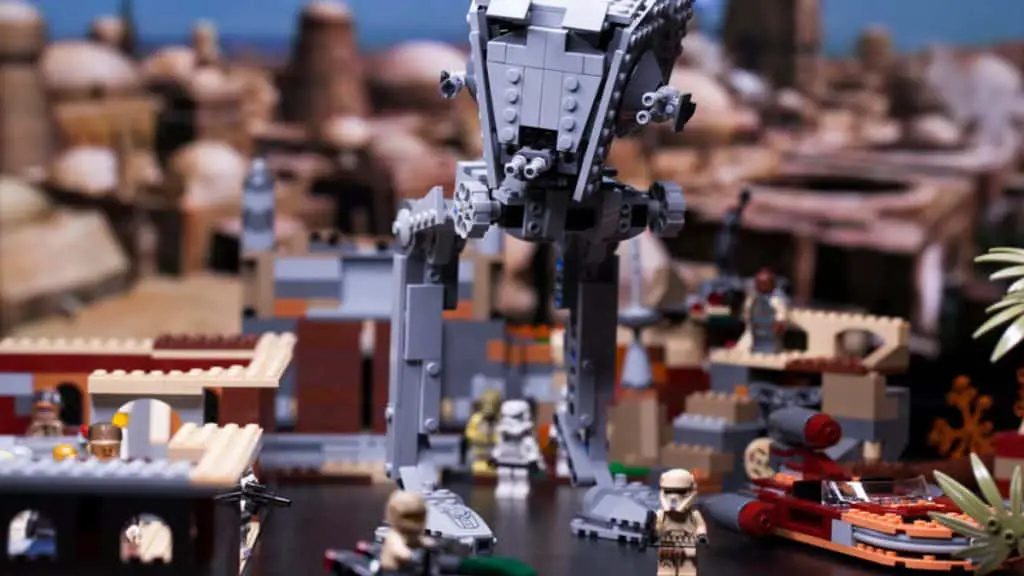
7 Best LEGO Star Wars Sets | Our Top Picks of All Time!
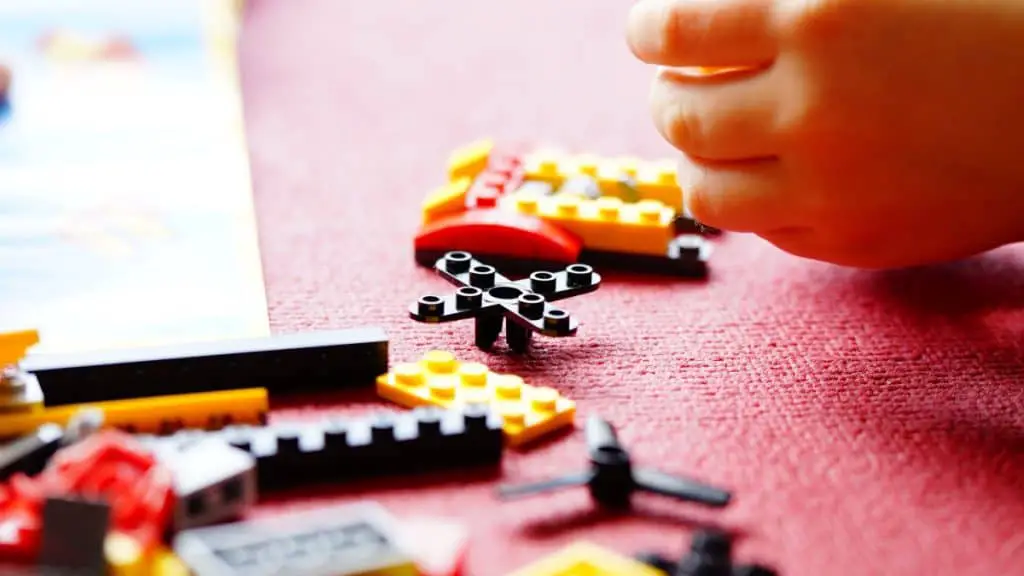
Best LEGO Creator Sets – Take Your Pick From These 7 Gems!
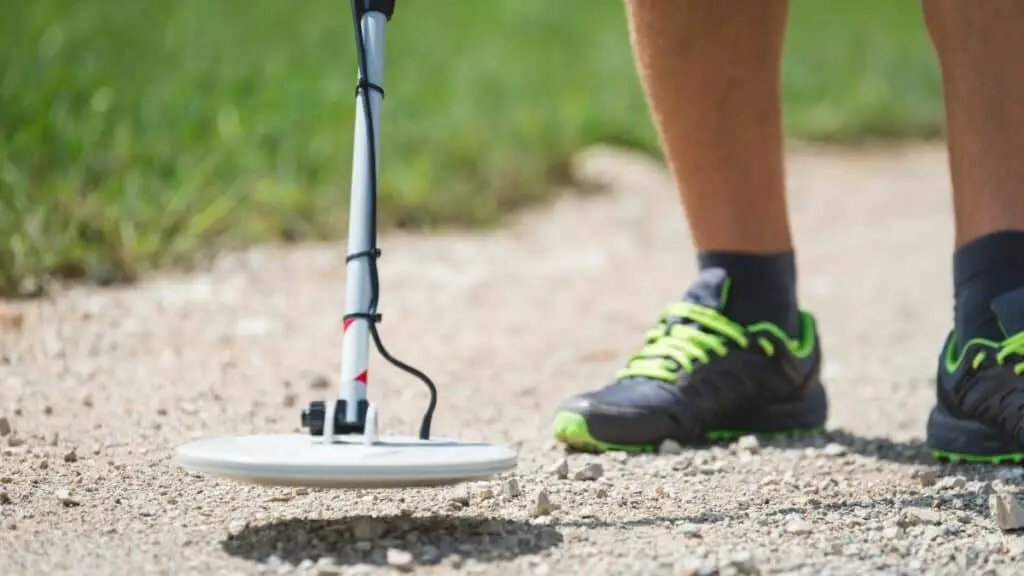
How to Use a Metal Detector: 8 Essential Tips to Get the Most of It
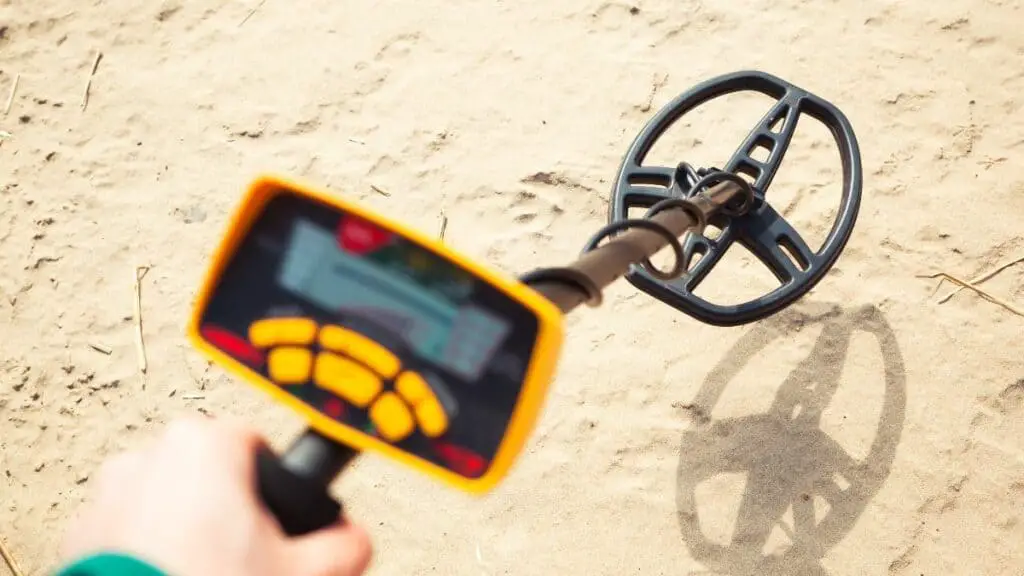
Best Metal Detector for Kids: 5 Top Picks (+ Buying Guide)
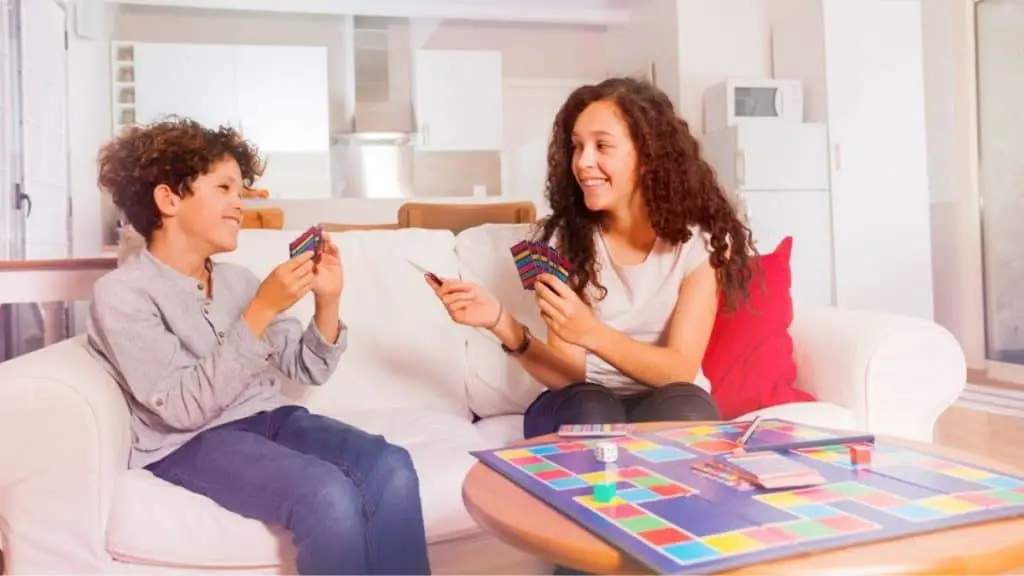
Best 2+ Player Cooperative Board Games (Top 6 in 2024)
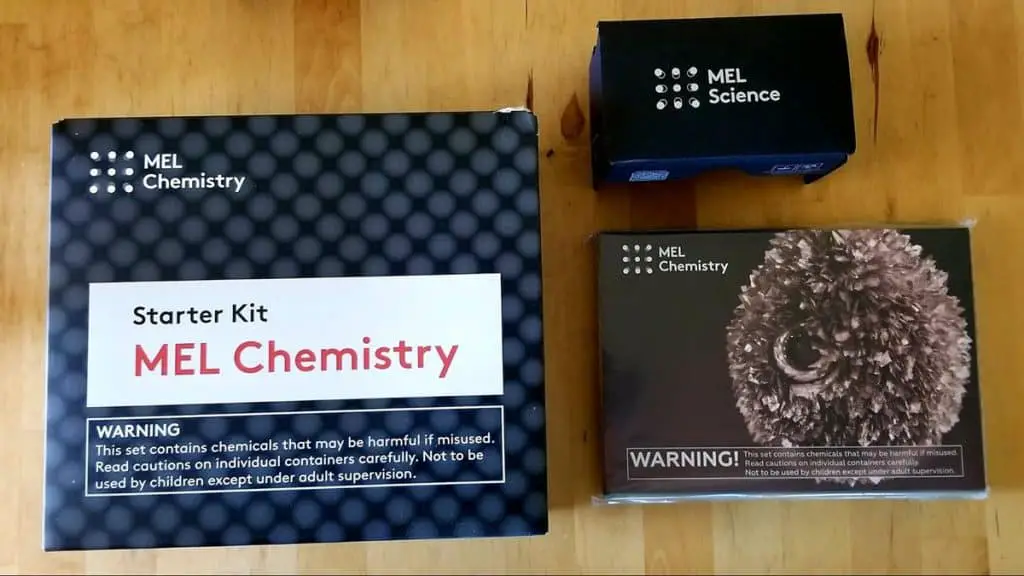
MEL Chemistry Review: Is Your Child the Next Bill Nye?
- Grades 6-12
- School Leaders
Don’t Miss Our List of the Top 2024-25 Competitions for Students in Grades K-12! 🏆
72 Easy Science Experiments Using Materials You Already Have On Hand
Because science doesn’t have to be complicated.
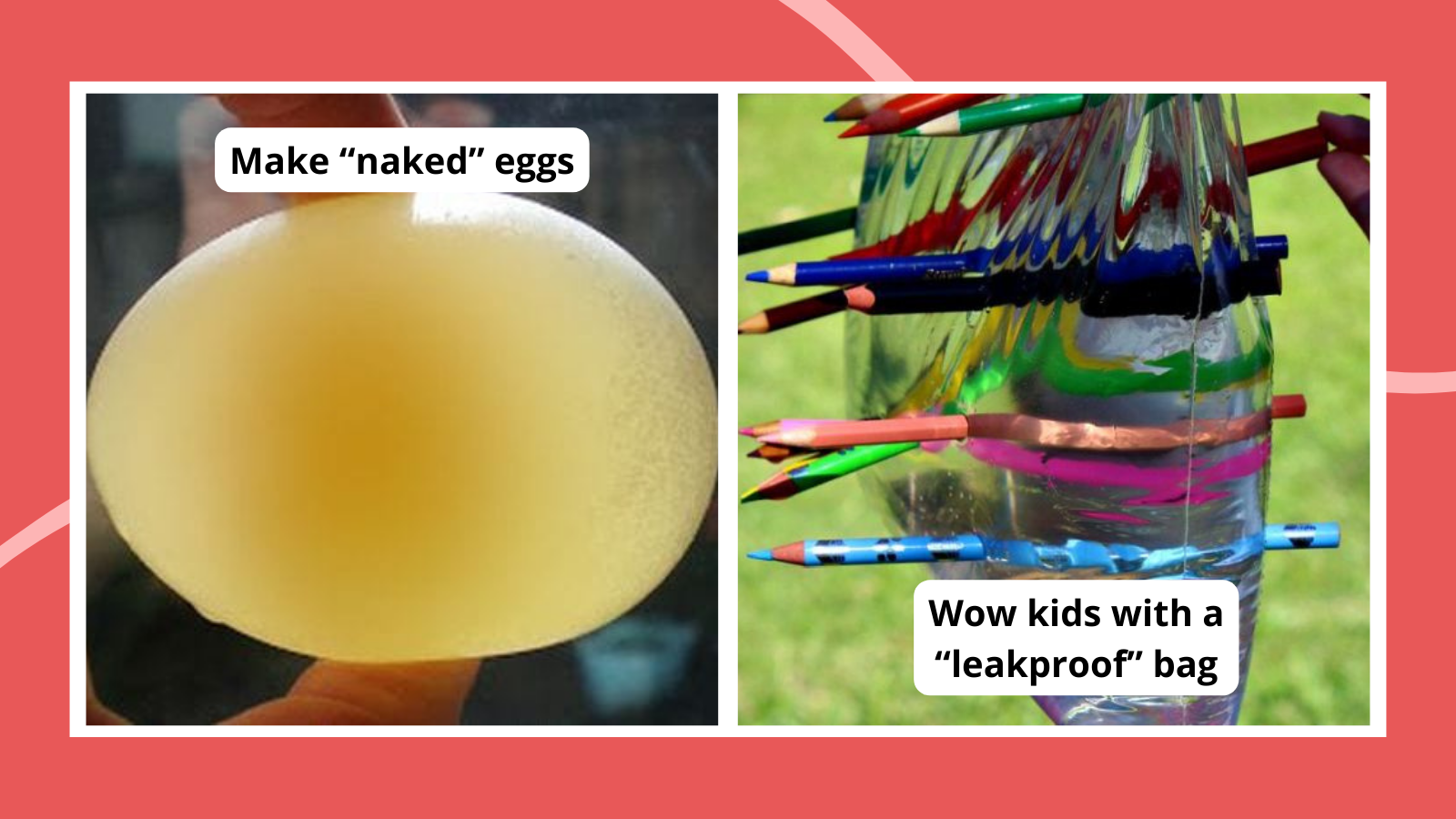
If there is one thing that is guaranteed to get your students excited, it’s a good science experiment! While some experiments require expensive lab equipment or dangerous chemicals, there are plenty of cool projects you can do with regular household items. We’ve rounded up a big collection of easy science experiments that anybody can try, and kids are going to love them!
Easy Chemistry Science Experiments
Easy physics science experiments, easy biology and environmental science experiments, easy engineering experiments and stem challenges.
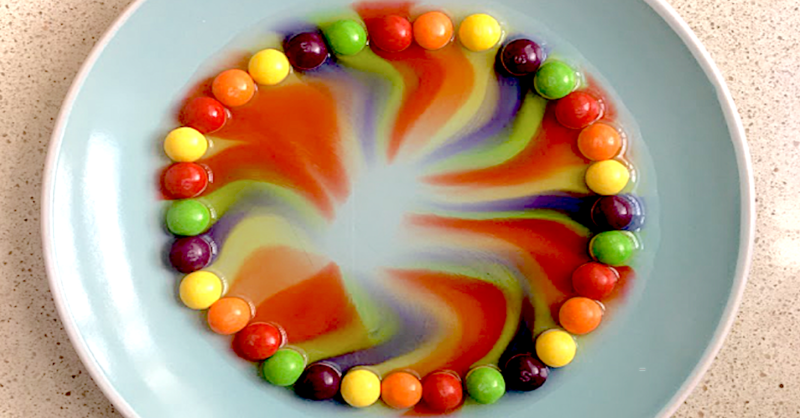
1. Taste the Rainbow
Teach your students about diffusion while creating a beautiful and tasty rainbow! Tip: Have extra Skittles on hand so your class can eat a few!
Learn more: Skittles Diffusion
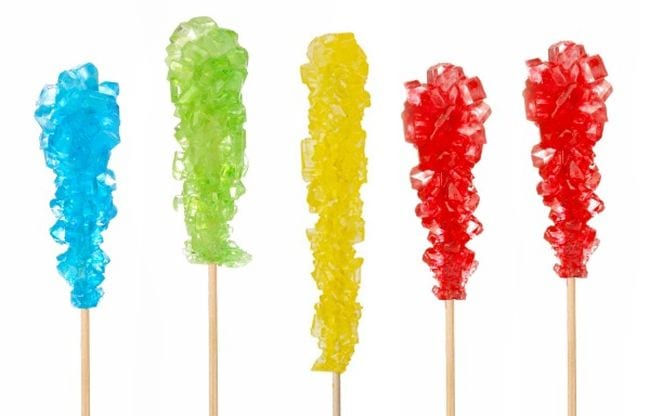
2. Crystallize sweet treats
Crystal science experiments teach kids about supersaturated solutions. This one is easy to do at home, and the results are absolutely delicious!
Learn more: Candy Crystals
3. Make a volcano erupt
This classic experiment demonstrates a chemical reaction between baking soda (sodium bicarbonate) and vinegar (acetic acid), which produces carbon dioxide gas, water, and sodium acetate.
Learn more: Best Volcano Experiments
4. Make elephant toothpaste
This fun project uses yeast and a hydrogen peroxide solution to create overflowing “elephant toothpaste.” Tip: Add an extra fun layer by having kids create toothpaste wrappers for plastic bottles.
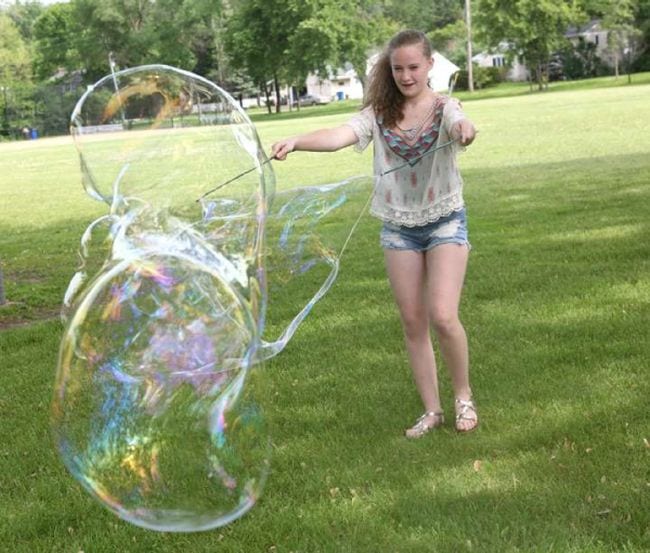
5. Blow the biggest bubbles you can
Add a few simple ingredients to dish soap solution to create the largest bubbles you’ve ever seen! Kids learn about surface tension as they engineer these bubble-blowing wands.
Learn more: Giant Soap Bubbles
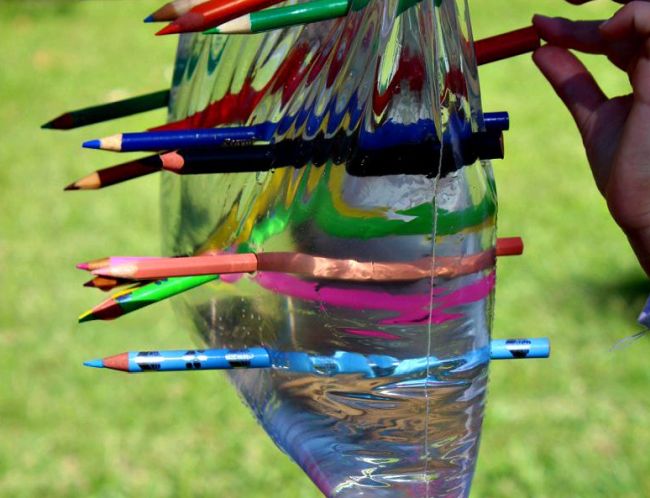
6. Demonstrate the “magic” leakproof bag
All you need is a zip-top plastic bag, sharp pencils, and water to blow your kids’ minds. Once they’re suitably impressed, teach them how the “trick” works by explaining the chemistry of polymers.
Learn more: Leakproof Bag
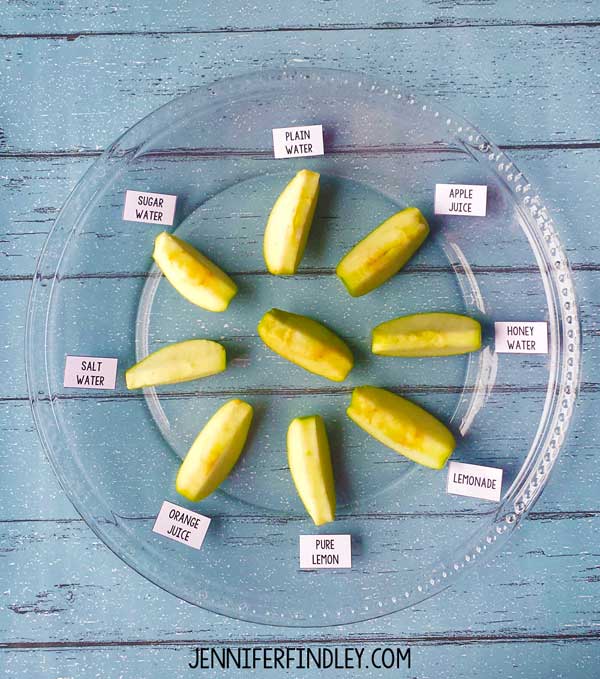
7. Use apple slices to learn about oxidation
Have students make predictions about what will happen to apple slices when immersed in different liquids, then put those predictions to the test. Have them record their observations.
Learn more: Apple Oxidation
8. Float a marker man
Their eyes will pop out of their heads when you “levitate” a stick figure right off the table! This experiment works due to the insolubility of dry-erase marker ink in water, combined with the lighter density of the ink.
Learn more: Floating Marker Man

9. Discover density with hot and cold water
There are a lot of easy science experiments you can do with density. This one is extremely simple, involving only hot and cold water and food coloring, but the visuals make it appealing and fun.
Learn more: Layered Water
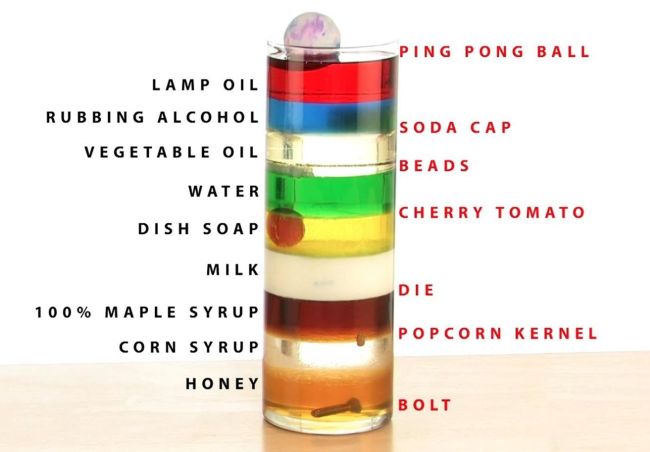
10. Layer more liquids
This density demo is a little more complicated, but the effects are spectacular. Slowly layer liquids like honey, dish soap, water, and rubbing alcohol in a glass. Kids will be amazed when the liquids float one on top of the other like magic (except it is really science).
Learn more: Layered Liquids
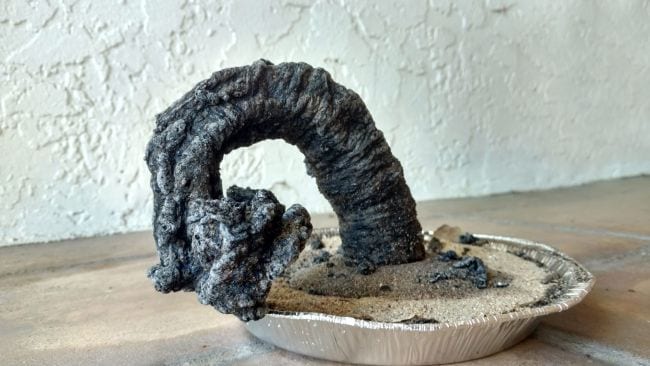
11. Grow a carbon sugar snake
Easy science experiments can still have impressive results! This eye-popping chemical reaction demonstration only requires simple supplies like sugar, baking soda, and sand.
Learn more: Carbon Sugar Snake
12. Mix up some slime
Tell kids you’re going to make slime at home, and watch their eyes light up! There are a variety of ways to make slime, so try a few different recipes to find the one you like best.
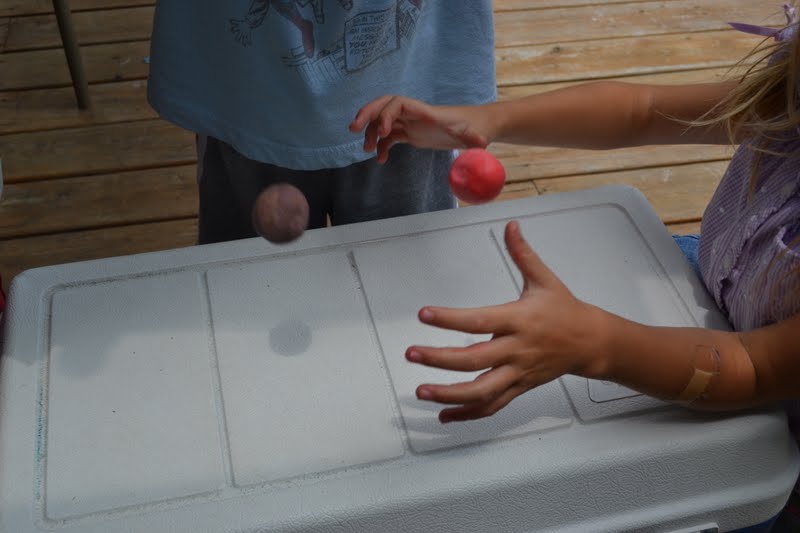
13. Make homemade bouncy balls
These homemade bouncy balls are easy to make since all you need is glue, food coloring, borax powder, cornstarch, and warm water. You’ll want to store them inside a container like a plastic egg because they will flatten out over time.
Learn more: Make Your Own Bouncy Balls

14. Create eggshell chalk
Eggshells contain calcium, the same material that makes chalk. Grind them up and mix them with flour, water, and food coloring to make your very own sidewalk chalk.
Learn more: Eggshell Chalk
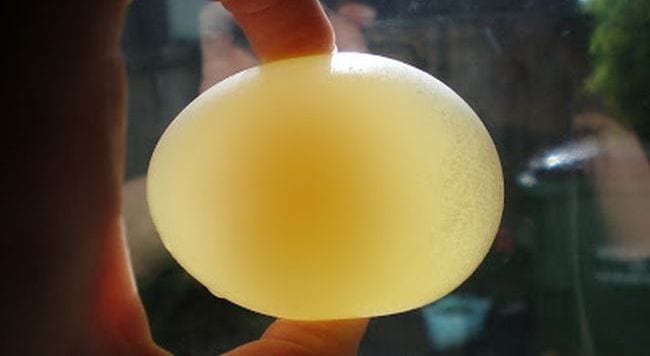
15. Make naked eggs
This is so cool! Use vinegar to dissolve the calcium carbonate in an eggshell to discover the membrane underneath that holds the egg together. Then, use the “naked” egg for another easy science experiment that demonstrates osmosis .
Learn more: Naked Egg Experiment
16. Turn milk into plastic
This sounds a lot more complicated than it is, but don’t be afraid to give it a try. Use simple kitchen supplies to create plastic polymers from plain old milk. Sculpt them into cool shapes when you’re done!
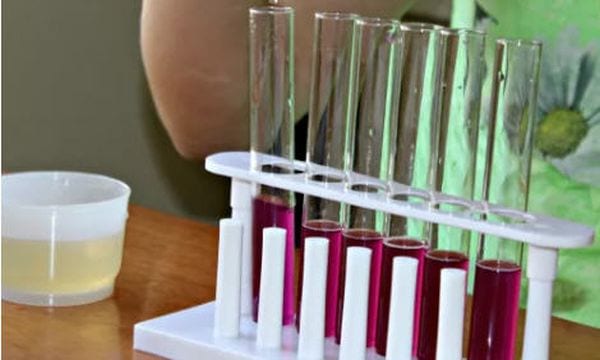
17. Test pH using cabbage
Teach kids about acids and bases without needing pH test strips! Simply boil some red cabbage and use the resulting water to test various substances—acids turn red and bases turn green.
Learn more: Cabbage pH
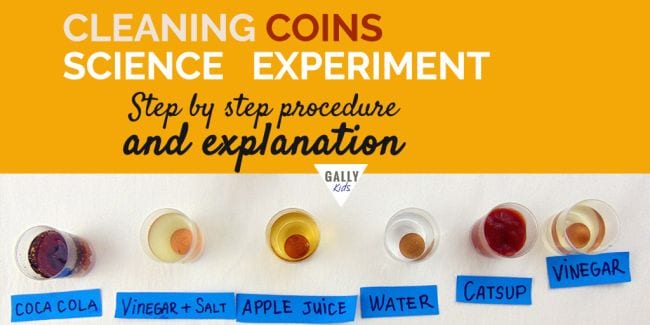
18. Clean some old coins
Use common household items to make old oxidized coins clean and shiny again in this simple chemistry experiment. Ask kids to predict (hypothesize) which will work best, then expand the learning by doing some research to explain the results.
Learn more: Cleaning Coins
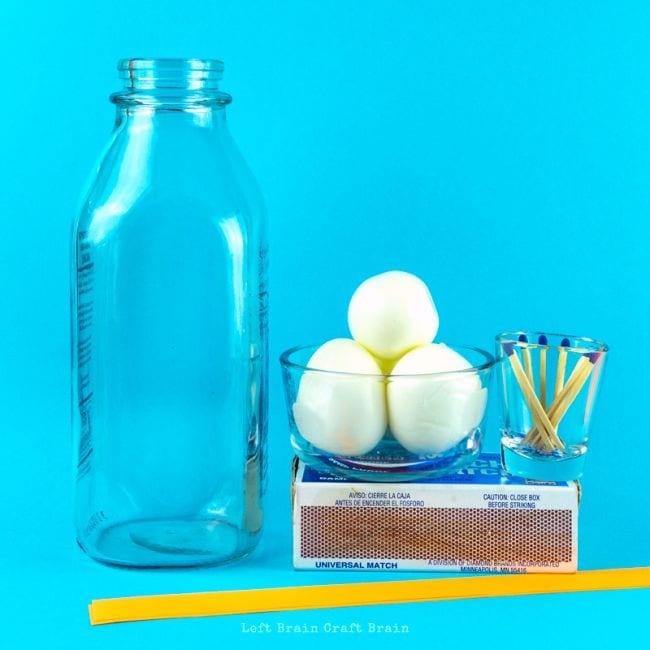
19. Pull an egg into a bottle
This classic easy science experiment never fails to delight. Use the power of air pressure to suck a hard-boiled egg into a jar, no hands required.
Learn more: Egg in a Bottle
20. Blow up a balloon (without blowing)
Chances are good you probably did easy science experiments like this when you were in school. The baking soda and vinegar balloon experiment demonstrates the reactions between acids and bases when you fill a bottle with vinegar and a balloon with baking soda.
21 Assemble a DIY lava lamp
This 1970s trend is back—as an easy science experiment! This activity combines acid-base reactions with density for a totally groovy result.
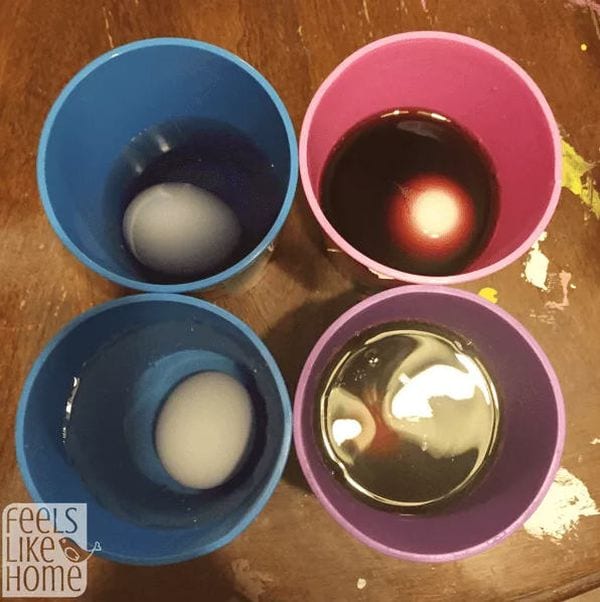
22. Explore how sugary drinks affect teeth
The calcium content of eggshells makes them a great stand-in for teeth. Use eggs to explore how soda and juice can stain teeth and wear down the enamel. Expand your learning by trying different toothpaste-and-toothbrush combinations to see how effective they are.
Learn more: Sugar and Teeth Experiment
23. Mummify a hot dog
If your kids are fascinated by the Egyptians, they’ll love learning to mummify a hot dog! No need for canopic jars , just grab some baking soda and get started.
24. Extinguish flames with carbon dioxide
This is a fiery twist on acid-base experiments. Light a candle and talk about what fire needs in order to survive. Then, create an acid-base reaction and “pour” the carbon dioxide to extinguish the flame. The CO2 gas acts like a liquid, suffocating the fire.
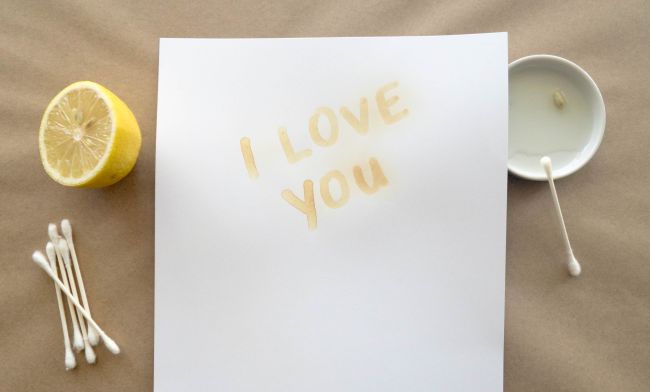
25. Send secret messages with invisible ink
Turn your kids into secret agents! Write messages with a paintbrush dipped in lemon juice, then hold the paper over a heat source and watch the invisible become visible as oxidation goes to work.
Learn more: Invisible Ink
26. Create dancing popcorn
This is a fun version of the classic baking soda and vinegar experiment, perfect for the younger crowd. The bubbly mixture causes popcorn to dance around in the water.
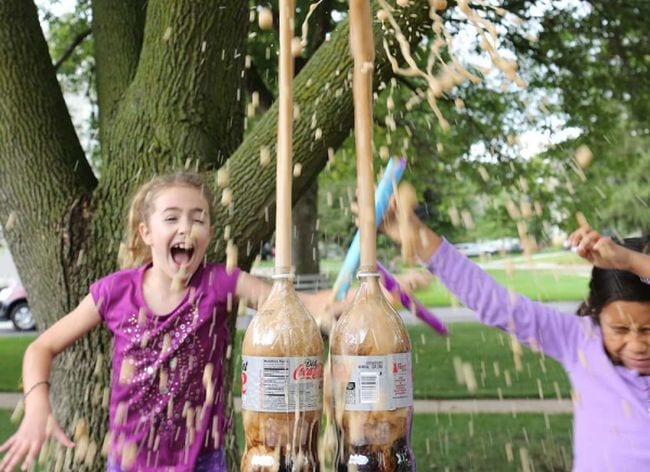

27. Shoot a soda geyser sky-high
You’ve always wondered if this really works, so it’s time to find out for yourself! Kids will marvel at the chemical reaction that sends diet soda shooting high in the air when Mentos are added.
Learn more: Soda Explosion
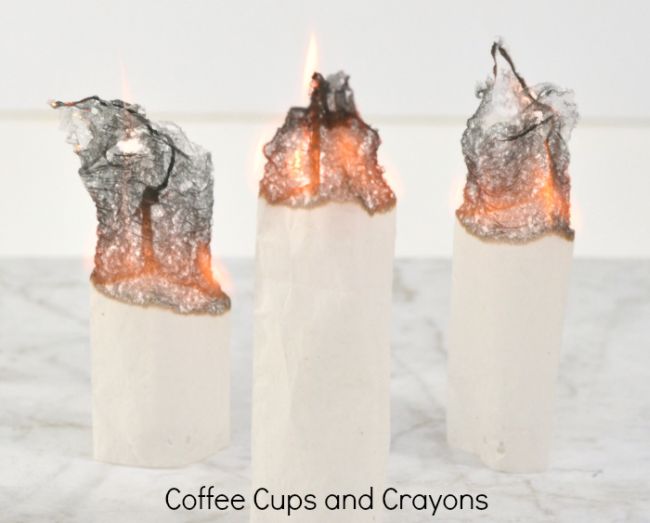
28. Send a teabag flying
Hot air rises, and this experiment can prove it! You’ll want to supervise kids with fire, of course. For more safety, try this one outside.
Learn more: Flying Tea Bags
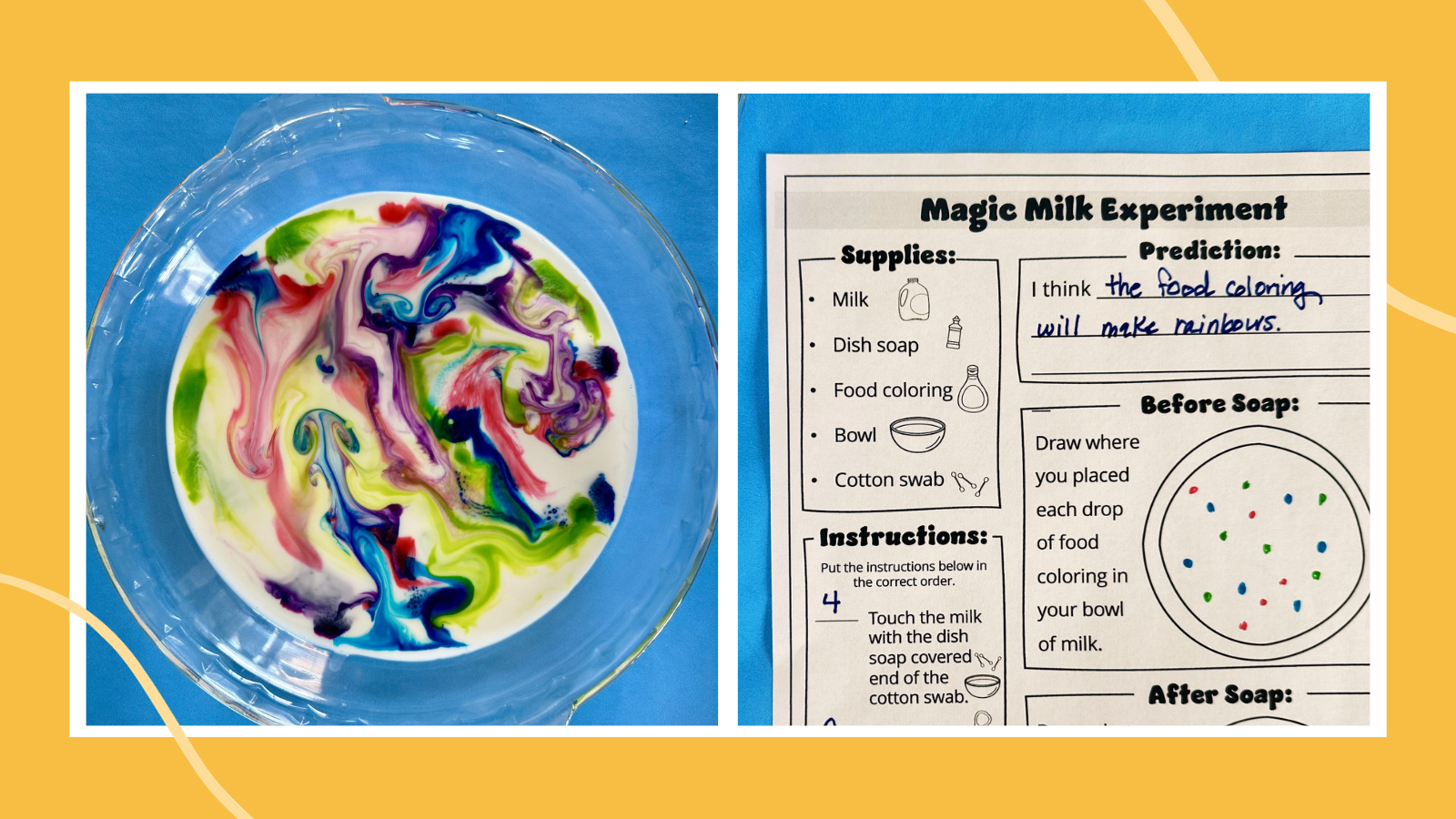
29. Create magic milk
This fun and easy science experiment demonstrates principles related to surface tension, molecular interactions, and fluid dynamics.
Learn more: Magic Milk Experiment
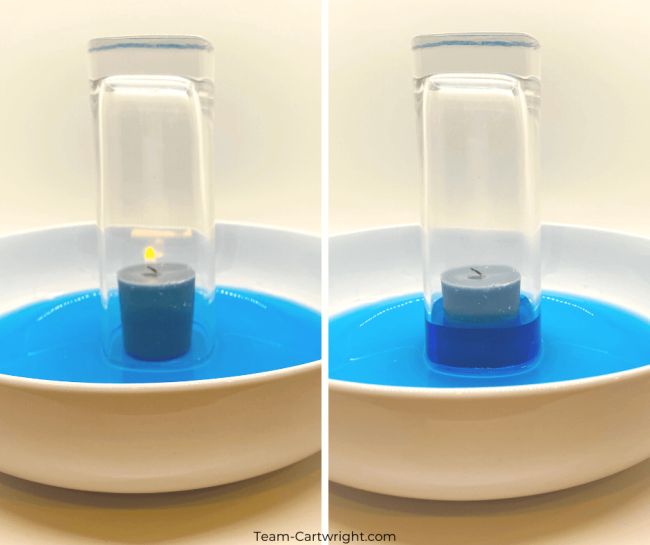
30. Watch the water rise
Learn about Charles’s Law with this simple experiment. As the candle burns, using up oxygen and heating the air in the glass, the water rises as if by magic.
Learn more: Rising Water
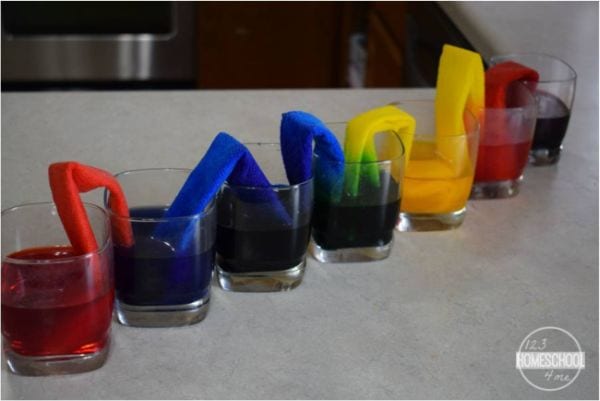
31. Learn about capillary action
Kids will be amazed as they watch the colored water move from glass to glass, and you’ll love the easy and inexpensive setup. Gather some water, paper towels, and food coloring to teach the scientific magic of capillary action.
Learn more: Capillary Action
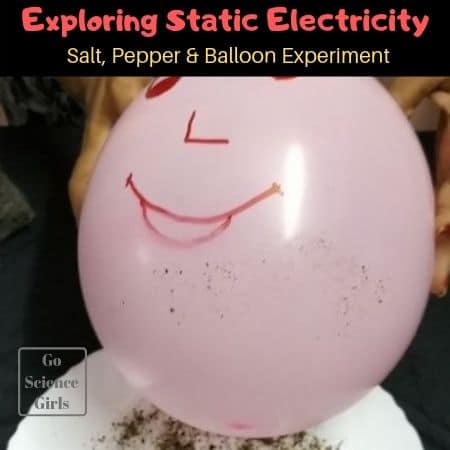
32. Give a balloon a beard
Equally educational and fun, this experiment will teach kids about static electricity using everyday materials. Kids will undoubtedly get a kick out of creating beards on their balloon person!
Learn more: Static Electricity
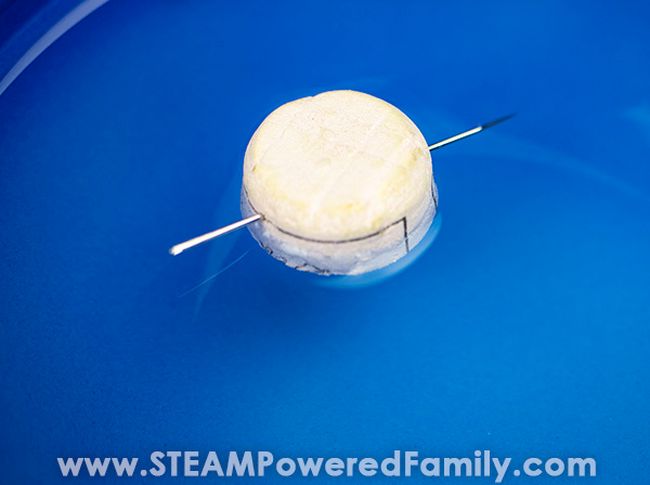
33. Find your way with a DIY compass
Here’s an old classic that never fails to impress. Magnetize a needle, float it on the water’s surface, and it will always point north.
Learn more: DIY Compass
34. Crush a can using air pressure
Sure, it’s easy to crush a soda can with your bare hands, but what if you could do it without touching it at all? That’s the power of air pressure!

35. Tell time using the sun
While people use clocks or even phones to tell time today, there was a time when a sundial was the best means to do that. Kids will certainly get a kick out of creating their own sundials using everyday materials like cardboard and pencils.
Learn more: Make Your Own Sundial
36. Launch a balloon rocket
Grab balloons, string, straws, and tape, and launch rockets to learn about the laws of motion.
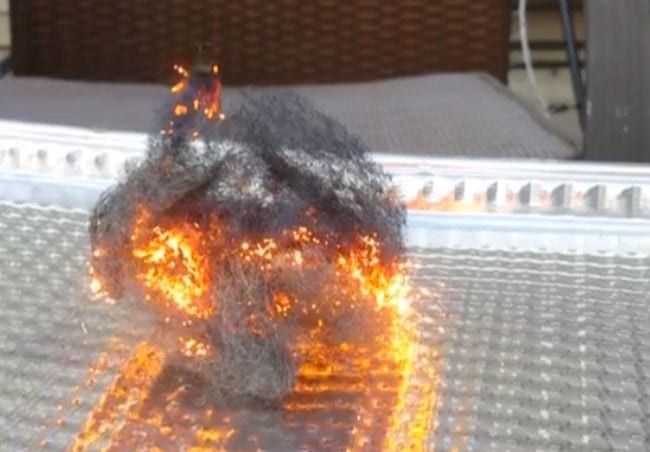
37. Make sparks with steel wool
All you need is steel wool and a 9-volt battery to perform this science demo that’s bound to make their eyes light up! Kids learn about chain reactions, chemical changes, and more.
Learn more: Steel Wool Electricity
38. Levitate a Ping-Pong ball
Kids will get a kick out of this experiment, which is really all about Bernoulli’s principle. You only need plastic bottles, bendy straws, and Ping-Pong balls to make the science magic happen.
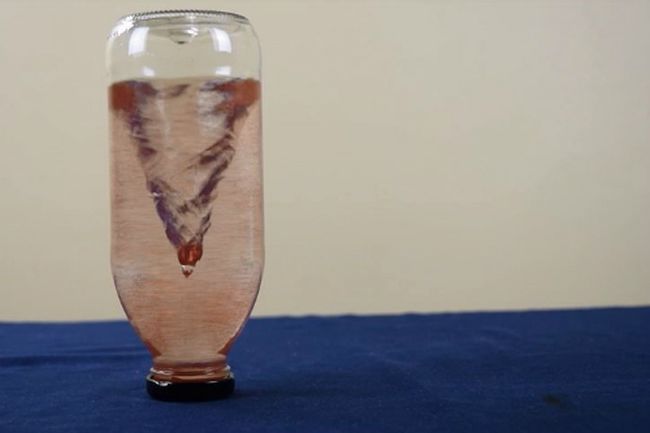
39. Whip up a tornado in a bottle
There are plenty of versions of this classic experiment out there, but we love this one because it sparkles! Kids learn about a vortex and what it takes to create one.
Learn more: Tornado in a Bottle
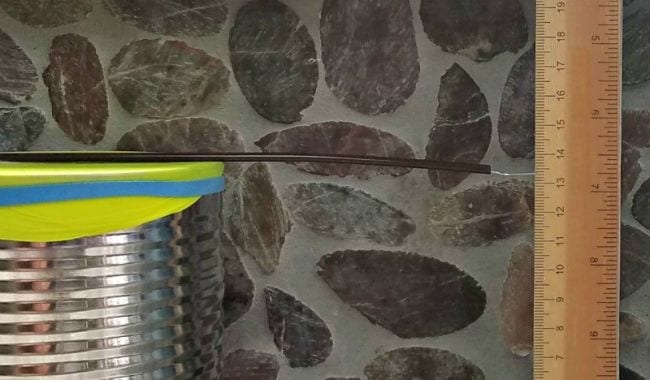
40. Monitor air pressure with a DIY barometer
This simple but effective DIY science project teaches kids about air pressure and meteorology. They’ll have fun tracking and predicting the weather with their very own barometer.
Learn more: DIY Barometer
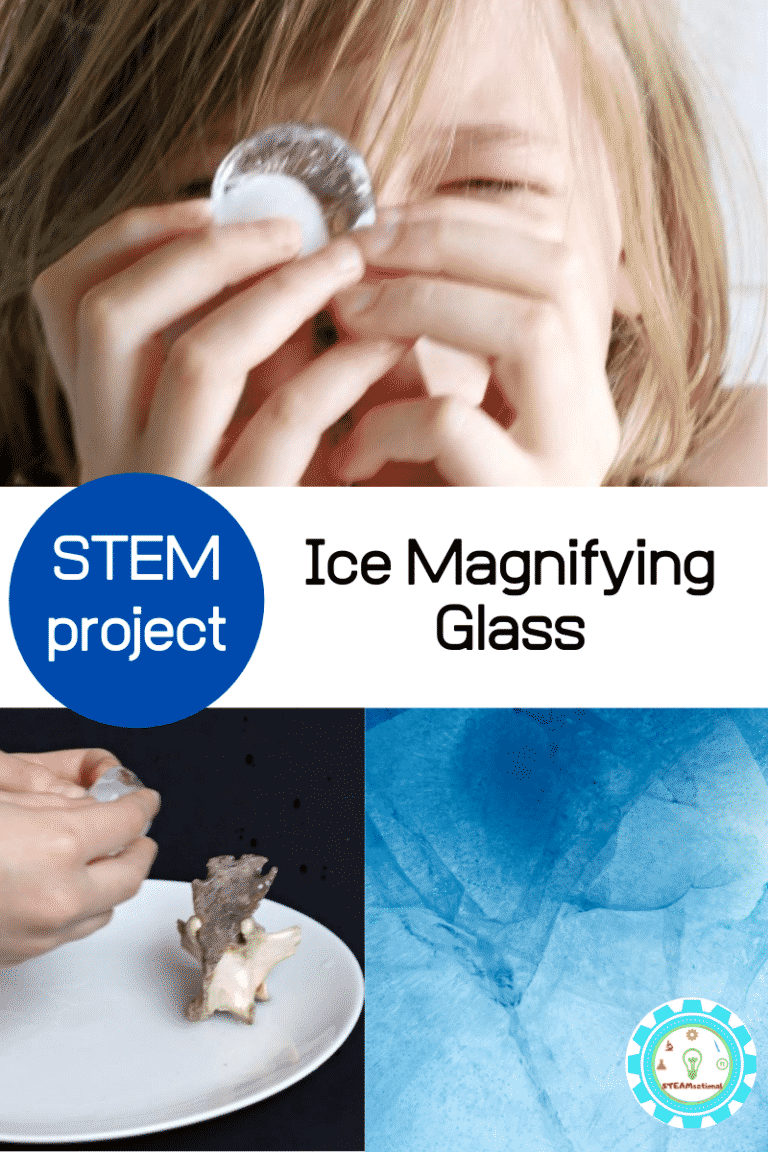
41. Peer through an ice magnifying glass
Students will certainly get a thrill out of seeing how an everyday object like a piece of ice can be used as a magnifying glass. Be sure to use purified or distilled water since tap water will have impurities in it that will cause distortion.
Learn more: Ice Magnifying Glass
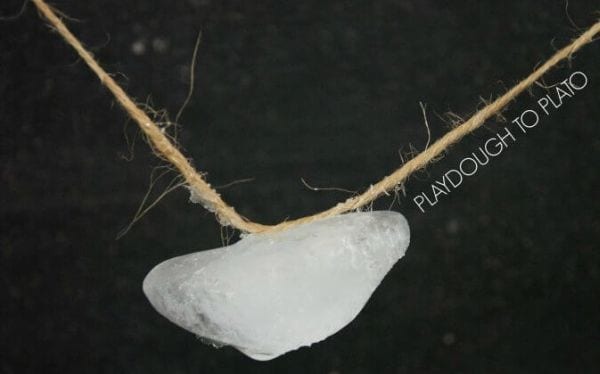
42. String up some sticky ice
Can you lift an ice cube using just a piece of string? This quick experiment teaches you how. Use a little salt to melt the ice and then refreeze the ice with the string attached.
Learn more: Sticky Ice
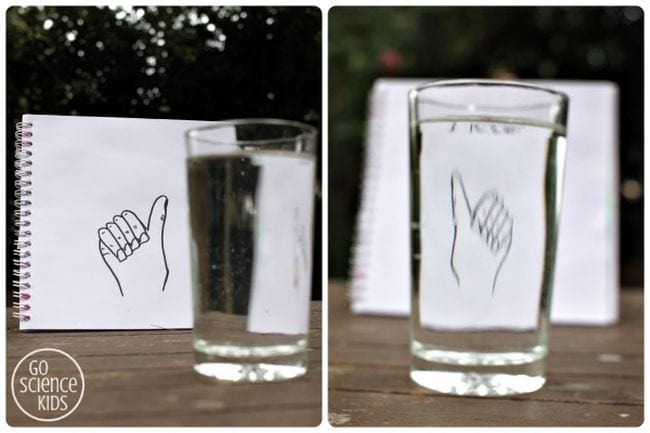
43. “Flip” a drawing with water
Light refraction causes some really cool effects, and there are multiple easy science experiments you can do with it. This one uses refraction to “flip” a drawing; you can also try the famous “disappearing penny” trick .
Learn more: Light Refraction With Water
44. Color some flowers
We love how simple this project is to re-create since all you’ll need are some white carnations, food coloring, glasses, and water. The end result is just so beautiful!
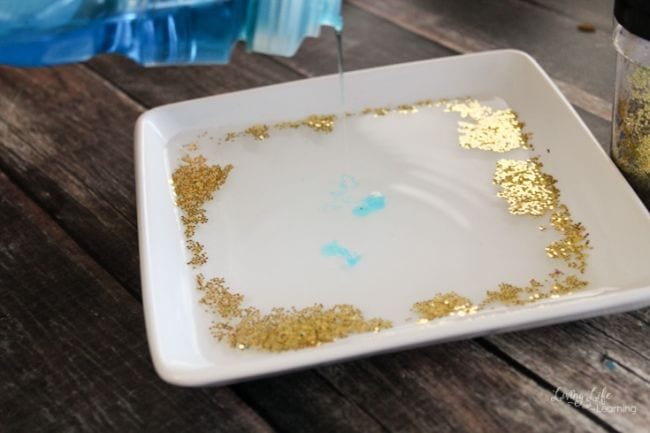
45. Use glitter to fight germs
Everyone knows that glitter is just like germs—it gets everywhere and is so hard to get rid of! Use that to your advantage and show kids how soap fights glitter and germs.
Learn more: Glitter Germs
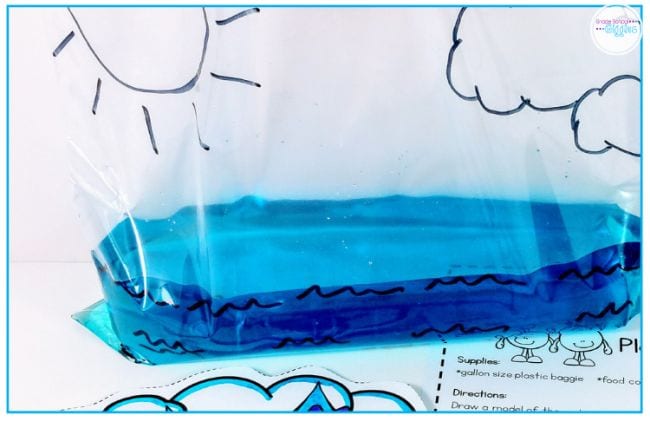
46. Re-create the water cycle in a bag
You can do so many easy science experiments with a simple zip-top bag. Fill one partway with water and set it on a sunny windowsill to see how the water evaporates up and eventually “rains” down.
Learn more: Water Cycle
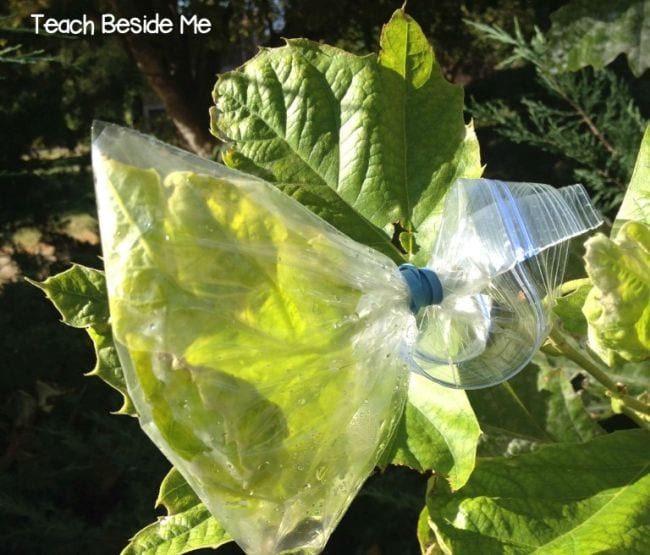
47. Learn about plant transpiration
Your backyard is a terrific place for easy science experiments. Grab a plastic bag and rubber band to learn how plants get rid of excess water they don’t need, a process known as transpiration.
Learn more: Plant Transpiration
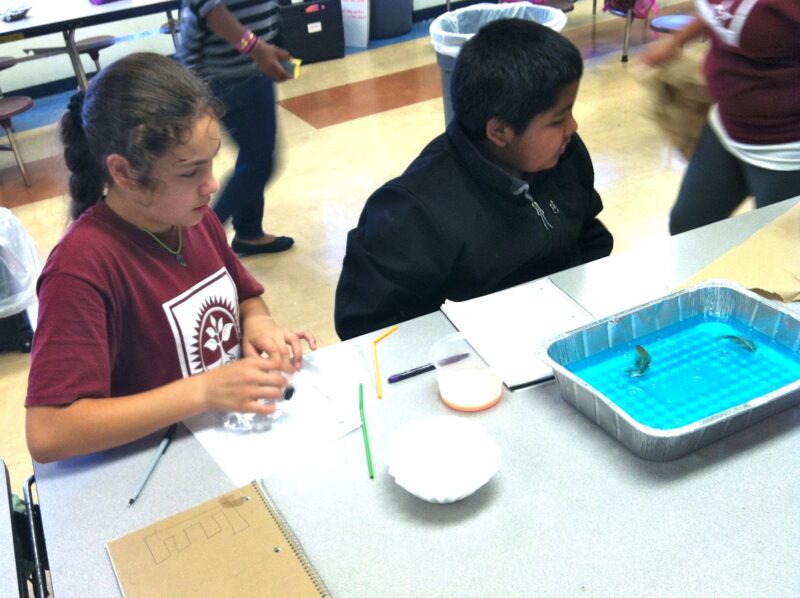
48. Clean up an oil spill
Before conducting this experiment, teach your students about engineers who solve environmental problems like oil spills. Then, have your students use provided materials to clean the oil spill from their oceans.
Learn more: Oil Spill
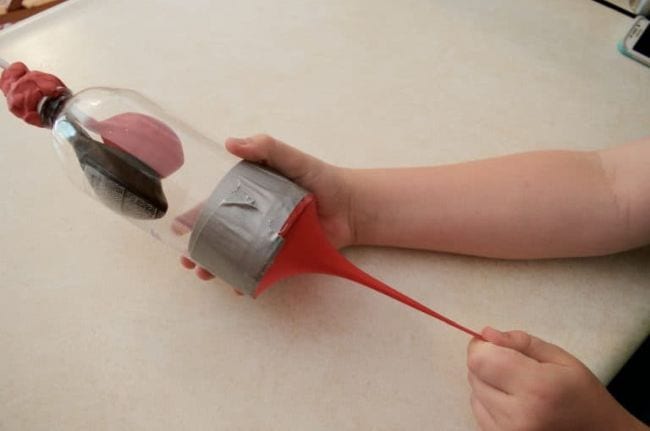
49. Construct a pair of model lungs
Kids get a better understanding of the respiratory system when they build model lungs using a plastic water bottle and some balloons. You can modify the experiment to demonstrate the effects of smoking too.
Learn more: Model Lungs
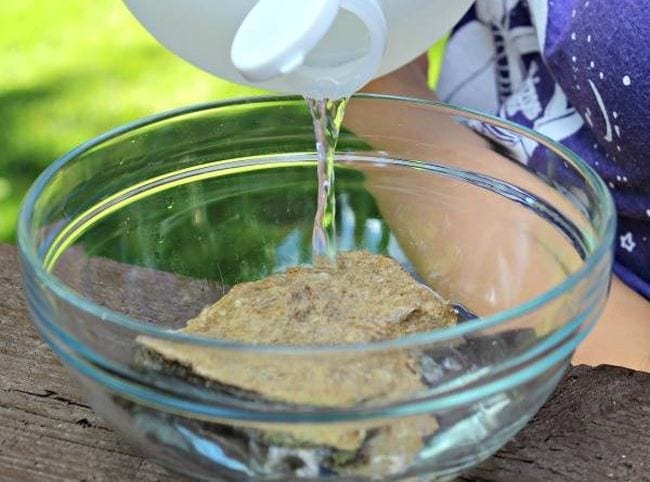
50. Experiment with limestone rocks
Kids love to collect rocks, and there are plenty of easy science experiments you can do with them. In this one, pour vinegar over a rock to see if it bubbles. If it does, you’ve found limestone!
Learn more: Limestone Experiments
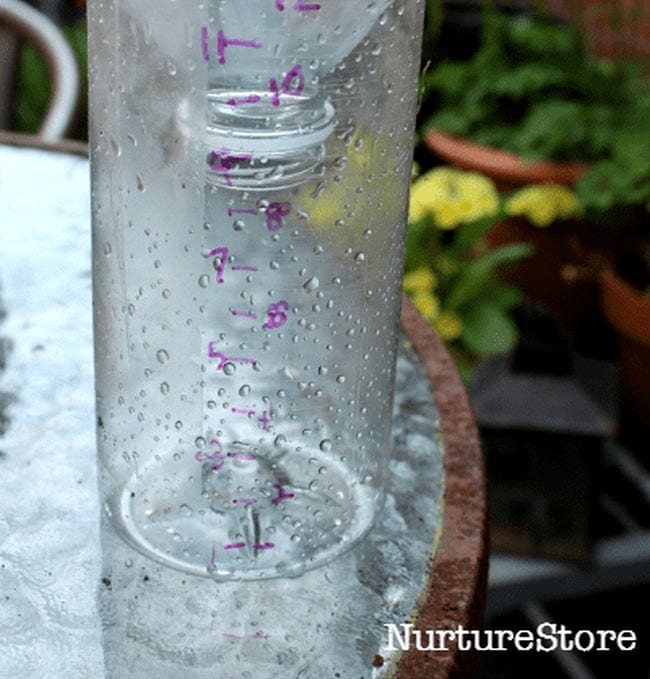
51. Turn a bottle into a rain gauge
All you need is a plastic bottle, a ruler, and a permanent marker to make your own rain gauge. Monitor your measurements and see how they stack up against meteorology reports in your area.
Learn more: DIY Rain Gauge
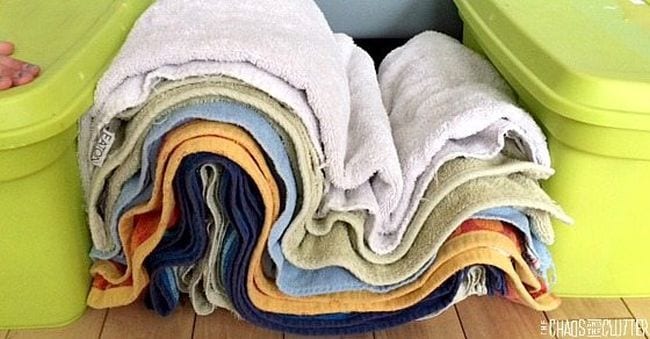
52. Build up towel mountains
This clever demonstration helps kids understand how some landforms are created. Use layers of towels to represent rock layers and boxes for continents. Then pu-u-u-sh and see what happens!
Learn more: Towel Mountains
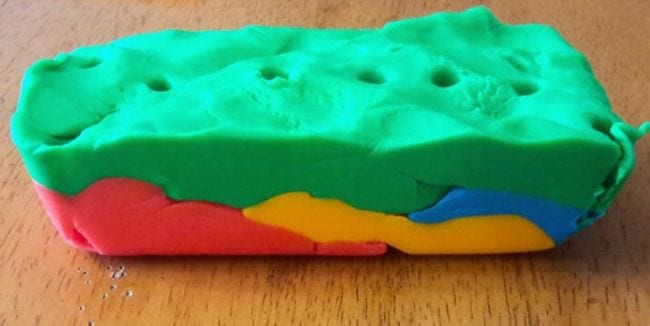
53. Take a play dough core sample
Learn about the layers of the earth by building them out of Play-Doh, then take a core sample with a straw. ( Love Play-Doh? Get more learning ideas here. )
Learn more: Play Dough Core Sampling
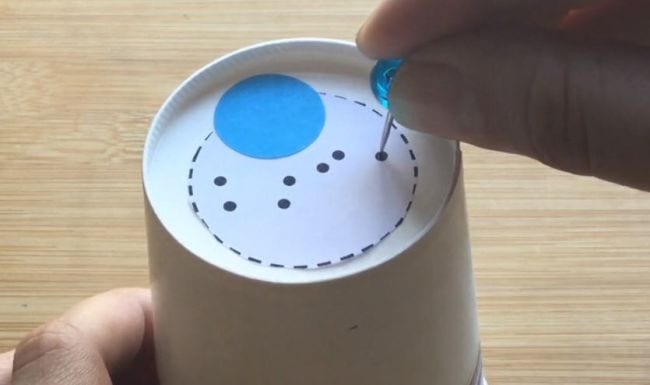
54. Project the stars on your ceiling
Use the video lesson in the link below to learn why stars are only visible at night. Then create a DIY star projector to explore the concept hands-on.
Learn more: DIY Star Projector
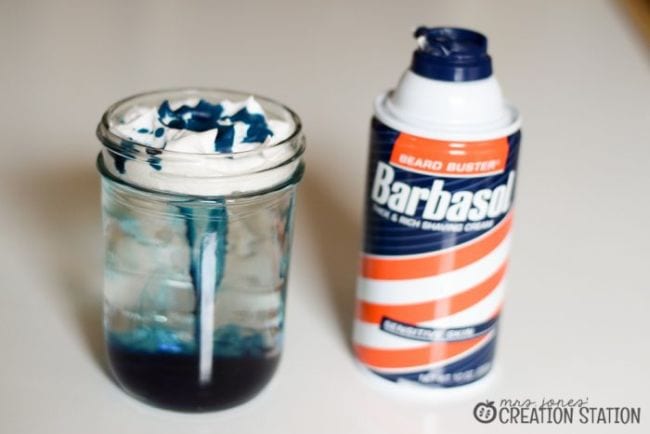
55. Make it rain
Use shaving cream and food coloring to simulate clouds and rain. This is an easy science experiment little ones will beg to do over and over.
Learn more: Shaving Cream Rain
56. Blow up your fingerprint
This is such a cool (and easy!) way to look at fingerprint patterns. Inflate a balloon a bit, use some ink to put a fingerprint on it, then blow it up big to see your fingerprint in detail.
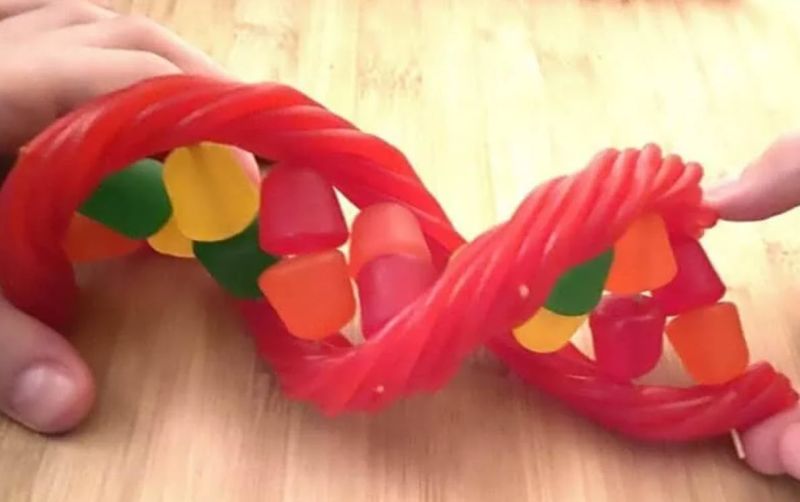
57. Snack on a DNA model
Twizzlers, gumdrops, and a few toothpicks are all you need to make this super-fun (and yummy!) DNA model.
Learn more: Edible DNA Model
58. Dissect a flower
Take a nature walk and find a flower or two. Then bring them home and take them apart to discover all the different parts of flowers.
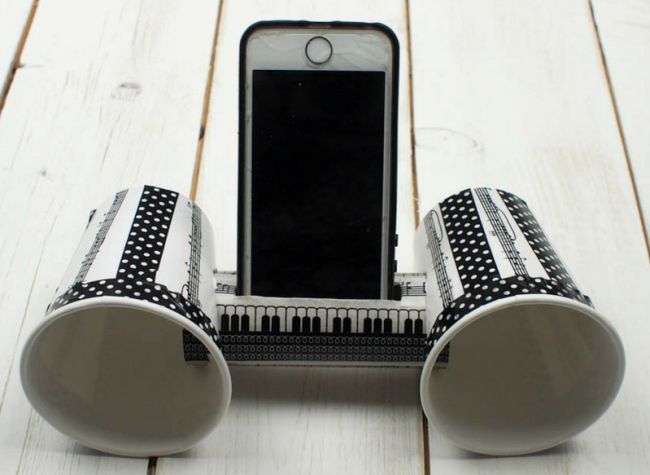
59. Craft smartphone speakers
No Bluetooth speaker? No problem! Put together your own from paper cups and toilet paper tubes.
Learn more: Smartphone Speakers
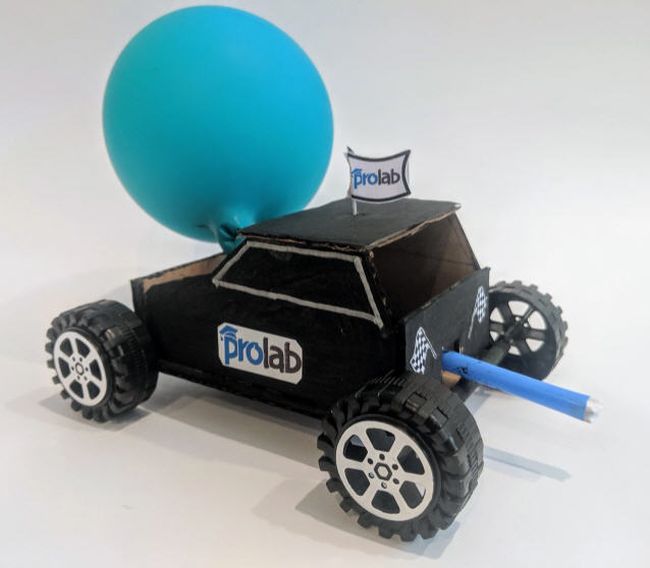
60. Race a balloon-powered car
Kids will be amazed when they learn they can put together this awesome racer using cardboard and bottle-cap wheels. The balloon-powered “engine” is so much fun too.
Learn more: Balloon-Powered Car
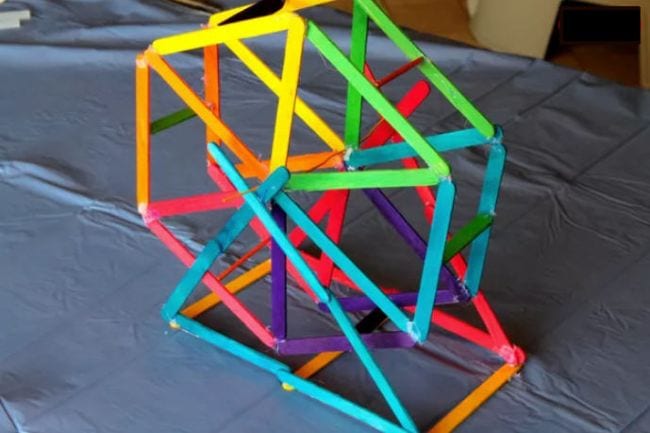
61. Build a Ferris wheel
You’ve probably ridden on a Ferris wheel, but can you build one? Stock up on wood craft sticks and find out! Play around with different designs to see which one works best.
Learn more: Craft Stick Ferris Wheel
62. Design a phone stand
There are lots of ways to craft a DIY phone stand, which makes this a perfect creative-thinking STEM challenge.
63. Conduct an egg drop
Put all their engineering skills to the test with an egg drop! Challenge kids to build a container from stuff they find around the house that will protect an egg from a long fall (this is especially fun to do from upper-story windows).
Learn more: Egg Drop Challenge Ideas
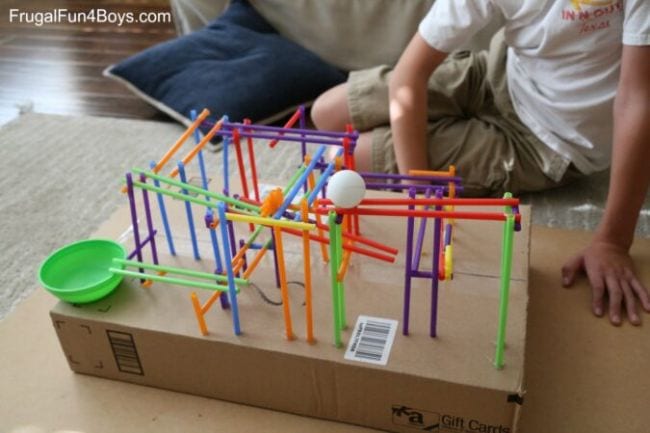
64. Engineer a drinking-straw roller coaster
STEM challenges are always a hit with kids. We love this one, which only requires basic supplies like drinking straws.
Learn more: Straw Roller Coaster
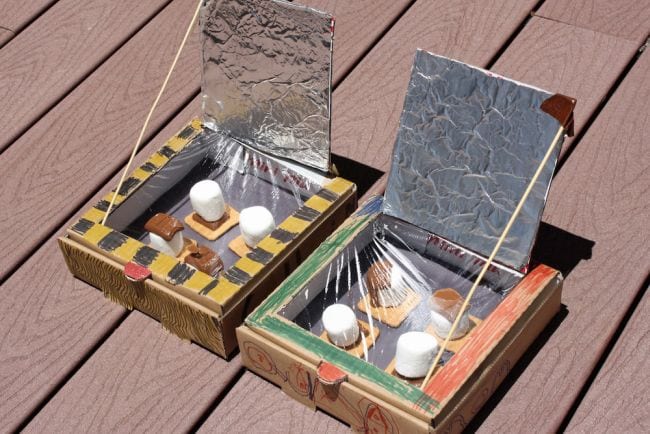
65. Build a solar oven
Explore the power of the sun when you build your own solar ovens and use them to cook some yummy treats. This experiment takes a little more time and effort, but the results are always impressive. The link below has complete instructions.
Learn more: Solar Oven
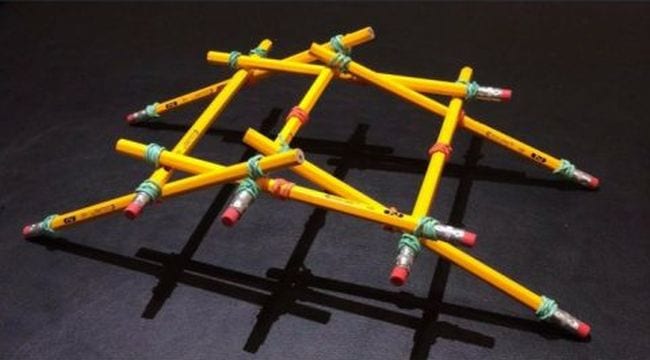
66. Build a Da Vinci bridge
There are plenty of bridge-building experiments out there, but this one is unique. It’s inspired by Leonardo da Vinci’s 500-year-old self-supporting wooden bridge. Learn how to build it at the link, and expand your learning by exploring more about Da Vinci himself.
Learn more: Da Vinci Bridge
67. Step through an index card
This is one easy science experiment that never fails to astonish. With carefully placed scissor cuts on an index card, you can make a loop large enough to fit a (small) human body through! Kids will be wowed as they learn about surface area.
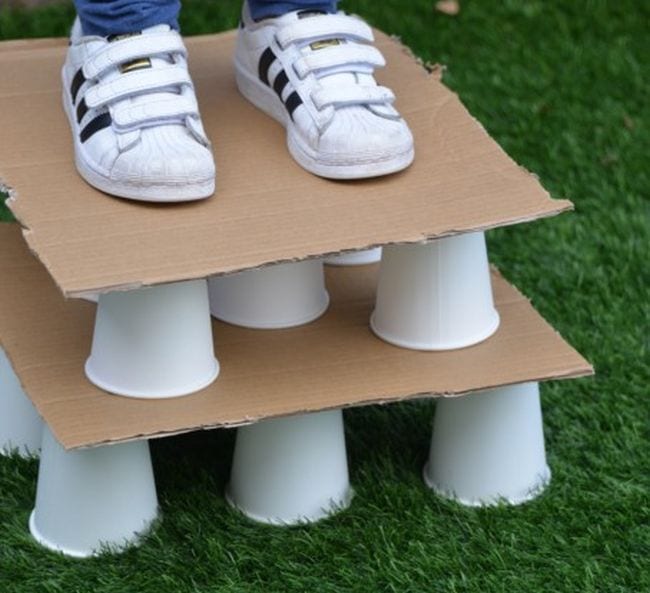
68. Stand on a pile of paper cups
Combine physics and engineering and challenge kids to create a paper cup structure that can support their weight. This is a cool project for aspiring architects.
Learn more: Paper Cup Stack
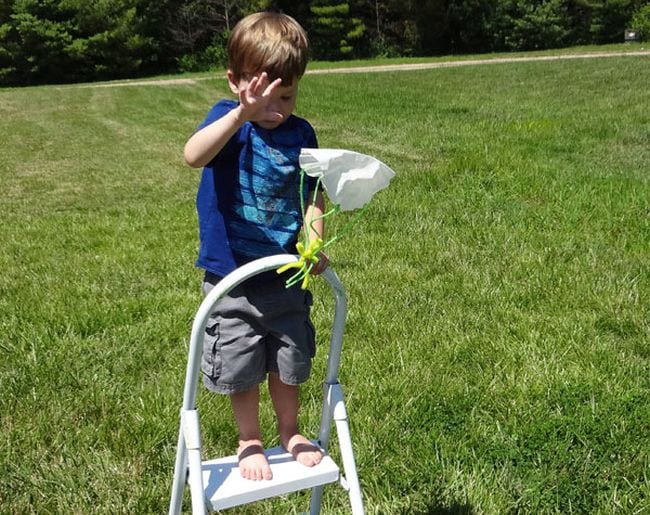
69. Test out parachutes
Gather a variety of materials (try tissues, handkerchiefs, plastic bags, etc.) and see which ones make the best parachutes. You can also find out how they’re affected by windy days or find out which ones work in the rain.
Learn more: Parachute Drop
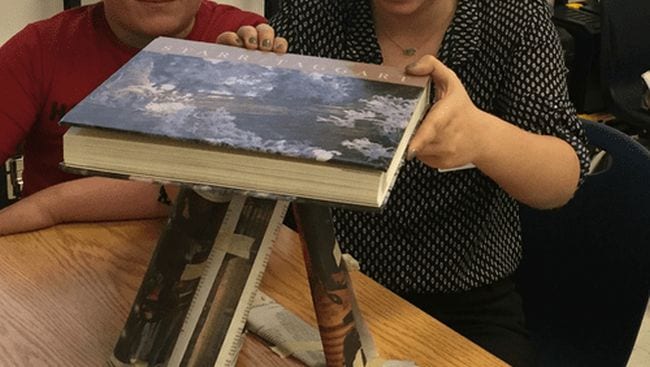
70. Recycle newspapers into an engineering challenge
It’s amazing how a stack of newspapers can spark such creative engineering. Challenge kids to build a tower, support a book, or even build a chair using only newspaper and tape!
Learn more: Newspaper STEM Challenge
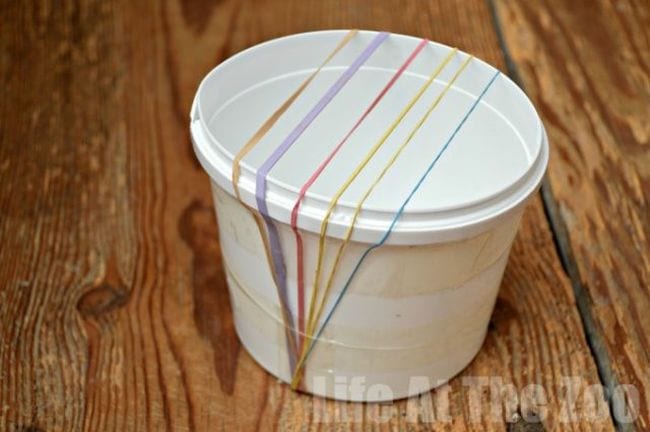
71. Use rubber bands to sound out acoustics
Explore the ways that sound waves are affected by what’s around them using a simple rubber band “guitar.” (Kids absolutely love playing with these!)
Learn more: Rubber Band Guitar
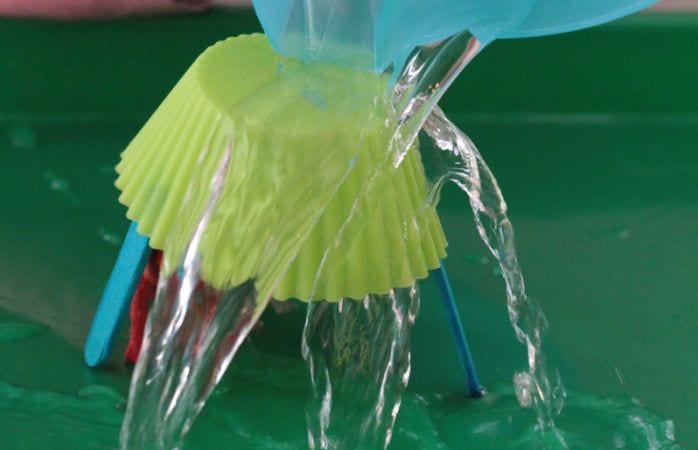
72. Assemble a better umbrella
Challenge students to engineer the best possible umbrella from various household supplies. Encourage them to plan, draw blueprints, and test their creations using the scientific method.
Learn more: Umbrella STEM Challenge
Plus, sign up for our newsletters to get all the latest learning ideas straight to your inbox.
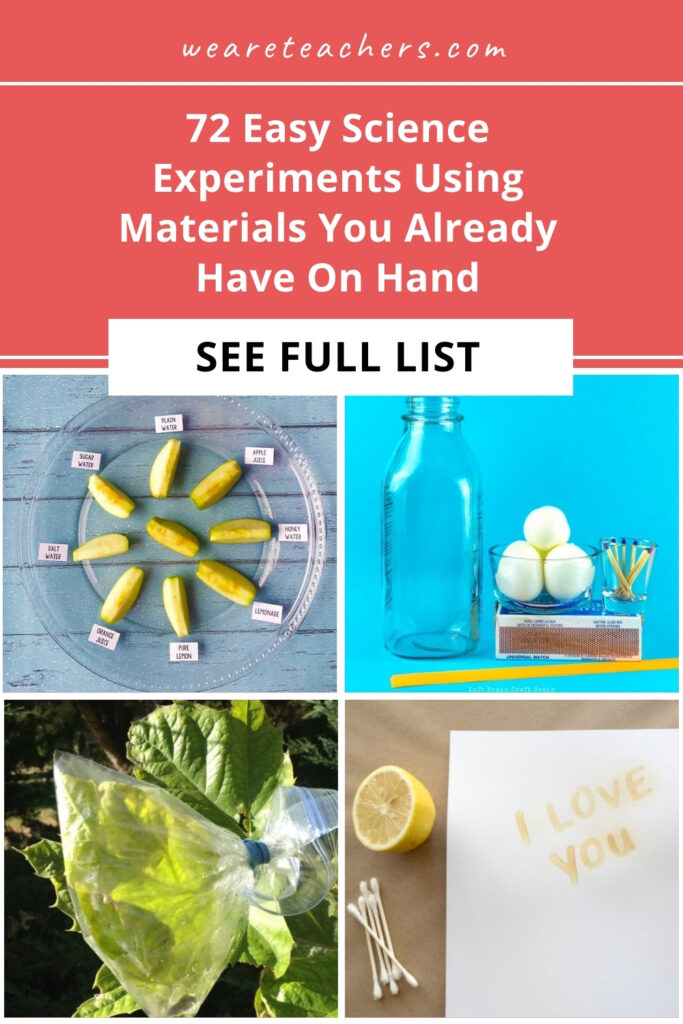
You Might Also Like
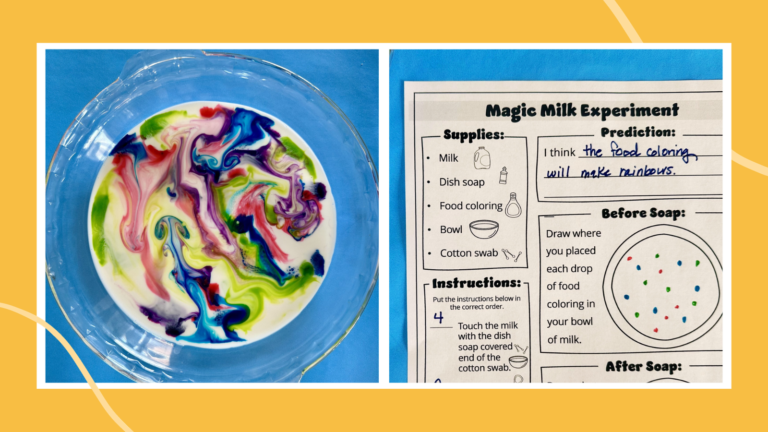
Magic Milk Experiment: How-To Plus Free Worksheet
This classic experiment teaches kids about basic chemistry and physics. Continue Reading
Copyright © 2024. All rights reserved. 5335 Gate Parkway, Jacksonville, FL 32256

IMAGES
VIDEO